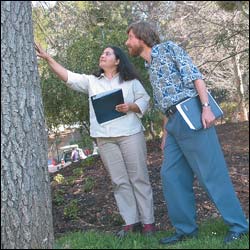Xerophytes hussle green invasives out of town
17 September 2004
Trunk call: ENGEO's Richard Hill and senior horticulturist Noelene le Cordier inspect an invasive poplar.
A quiet revolution is happening on campus as malingering pockets of invasive vegetation get their comeuppance, horticulturally speaking.
Take the new bed along the façade of the molecular and cell biology building on University Avenue North. UCT's senior horticulturist Noelene le Cordier and her team have re-landscaped it. The bushy, alien shrubs have been run out of town, replaced by an elegant supplanting of local flora. When you next pass that way, note the clumps of indigenous strelitzias, sour figs, vygies and succulents, with the three young cypresses standing guard. (The non-indigenous cypresses, says Le Cordier, continue the visual theme from the Jameson Plaza and the entrance to the university.)
Best of all is that the plants are xerophytic, or drought resistant, requiring scant watering. "It's the way you have to landscape in South Africa. We [horticulturists] call it xeriscaping," Le Cordier explains, flexing green fingers.
The invasives on campus are trembling to their roots. In some cases, their trunks are numbered. The site flanking Ring Road near the new chemical engineering building, is a case in point. Le Cordier and Richard Hill (environmental and geographical science) have been working together to weed out the bad 'uns, cleaning up the verges and small thickets along the borders of South Lane.
They plan some tree surgery, felling and replacement by the company, Trees-South Africa, the idea being to partially remove and clean up the invasive alien blackwood forest between Ring Road and the Shell ENGEO building.
Phasing out the poorest blackwoods (24 are unstable and potentially dangerous) will create space for new indigenous trees, which will be planted under the protective canopy of the remaining blackwoods.
"This creates an opportunity for graduates to donate yellowwood and stinkwood trees for planting in this area," Hill adds optimistically.
The large poplars flanking South Lane will be pruned and the dead wood removed. On the island between the ENGEO building and the new chemical engineering facility, the self-sown poplars will be removed and Dombeya rotundifolias planted. The plane trees below the embankment will be lightly pruned.
Already, the neighbourhood has experienced an upsurge. Students are enjoying the lush grass lawn to the side of the substation (lured by no doubt by the exotic aromas wafting from Falafel Ali's al fresco stall alongside).
The area has borne the brunt of lengthy building operations, strangled by rubble and self-seeding blackwood trees, but is now getting some well-deserved TLC - in this case tree love and care.
One troublesome varmint is a four-trunked poplar, a sinewy-branched, grey-barked deviant that leans precariously towards the ENGEO building as if eavesdropping on the lecturers. ("What was that he said about global warming?") Its roots have spread insidiously towards the main doors, buckling the paving. This is one that will have to be cut down to size, providing proper room for the young saplings huddling in its shadow.
So spread the word: the university is continuing its indigenous and waterwise campaign and the invasives are trembling to their primary roots.
This campus isn't big enough for the likes of them.
 This work is licensed under a Creative Commons Attribution-NoDerivatives 4.0 International License.
This work is licensed under a Creative Commons Attribution-NoDerivatives 4.0 International License.
Please view the republishing articles page for more information.










